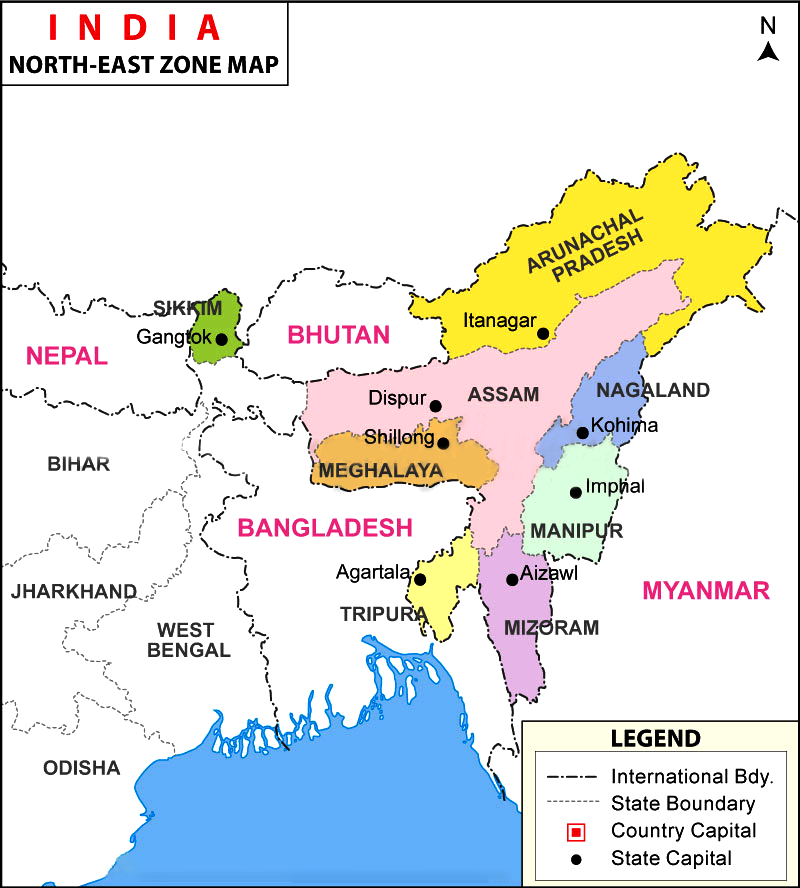Statehood Day of Arunachal Pradesh and Mizoram | 20 Feb 2021
Why in News
The Prime Minister of India extended his wishes to the people of Arunachal Pradesh and Mizoram on their 35th Statehood Day.
- Mizoram became the 23rd state of India on the same day, with the 53rd Amendment of the Indian Constitution, 1986.
- Similarly, through the 55th amendment to the Indian Constitution in 1986, Arunachal Pradesh became the 24th state of the Indian Union on 20th February, 1987.
Mizoram
- Historical background: The Mizo hills area became the Lushai Hills district within Assam at the time of independence. Further, in 1954 it was renamed the Mizo Hills District of Assam.
- Mizoram was granted the status of a Union Territory in 1972 after signing an accord with the moderates of the Mizo National Front (MNF).
- The Union Territory of Mizoram was conferred the status of a full state in 1986 after signing of a memorandum of settlement (Mizoram Peace Accord) between the Central government and the MNF.
- Geographical Location:
- International Border: Myanmar and Bangladesh
- State Border: Tripura (northwest), Assam (north) and Manipur (northeast).
- Demography: Mizoram is the second least populous state of the country holding a population of 400,309.
- The Sex Ratio is 975 female per 1000 male (National: 943)
- The Literacy rate of the state is 91.58 % (National: 74.04%)
- Biodiversity: According to India State of Forest Report (ISFR), 2019 Mizoram has the maximum forest cover as a percentage of their own geographical area at (85.4%).
- State Animal: Saza (serow)
- State Bird: Vavu (Hume Bartailed Pheasant).
- Protected Areas:
- Dampa Tiger Reserve
- Murlen National Park
- Phawngpui National Park
- Ngengpui Wildlife Sanctuary
- Tawi Wildlife Sanctuary
- Tribals: It has the highest concentration (percentage) of tribal population among all states of India.
- Mizos consist of 5 major and 11 minor tribes known as Awzia. The 5 major tribes include: Lushei, Ralte, Hmar, Paihte and Pawi.
- The Mizos are a close- knit society with no class distinction and discrimination on grounds of sex, status or religion.
- Mizos are agriculturists, practise “Jhum Cultivation” or slash- and- burn system of cultivation.
- Festivals and Dance: The Mizos have two main festivals- Mim Kut and Chapchar Kut.
- Chapchar Kut: It is a Spring Festival, most popular and celebrated after completion of the task of jungle clearing for “jhum” operations.
- Mim Kut: It is a Maize festival that is celebrated during the months of August and September, after the harvest of maize.
- The most colourful and distinctive dance of the Mizo is called Cheraw. Long bamboo staves are used for this dance, therefore many people call it ‘Bamboo Dance’.
Arunachal Pradesh
- Historical Background: During the British Colonial Rule, until 1972, the state was named as the North-East Frontier Agency (NEFA).
- On 20th January, 1972, it became a Union Territory and named Arunachal Pradesh.
- Geographical location: The state was formed out of Assam in the year 1987.
- In the west, Arunachal Pradesh is bordered by Bhutan and in the north falls the Tibetan region of China.
- In the Southeastern region falls Nagaland and Myanmar and to the southwestern region falls Assam.
- Demography: The capital of Arunachal Pradesh is Itanagar.
- The total literacy rate of the state (as per Census 2011) is 65.38% with male literacy rate being 72.55% and for females, it is 57.70%.
- The Sex Ratio of the states is 938 female per 1000 male (National: 943)
- The state is home to 26 major tribes, there are more than 100 sub-tribes, many of them are still unexplored. About 65% of the population of the state is tribals.
- Occupation: Mostly the population of the state depends on Agriculture, mainly Jhum cultivation (slash and burn cultivation).
- Other cultivation of cash crops is also done like potatoes.
- Horticulture crops such as pineapple, apple, oranges, etc are also done.
- Biodiversity:
- State Animal: Mithun (also known as Gayal)
- State Bird: Hornbill
- It is also home to the Dihang Dibang Biosphere Reserve.
- Protected Areas:
- Namdapha National Park
- Mouling National Park
- Sessa Orchid Sanctuary
- Dibang Wildlife Sanctuary
- Pakke Tiger Reserve
- Tribals of Arunachal: The significant tribal groups include Monpas, Nyishis, Apatanis, Noctes and Sherdukpens.
- Monpas: They are believed to be the only nomadic tribe of northeast, inhabit the West Kameng and Tawang districts, are essentially Buddhists who follow the Mahayana sect.
- Apatanis: They practice pre-Aryan beliefs, which is evident from their worship of trees, rocks and plants amongst other things. They mainly practise bamboo cultivation.
- Noctes: Found in the Tirap district, they follow Theravada Buddhism and Animism.
- Sherdukpens: A small tribal group, they are one of the most progressive tribes that can be found in Arunachal Pradesh practising agriculture, fishing and rearing of livestock. Although they have adopted Buddhism, most of their practices still remain pre-Buddhist and more Animistic.
- Nyishis: They are the most populous tribe of Arunachal Pradesh and are mainly involved in shifting cultivation and produce rice, millet, cucumber, etc.

